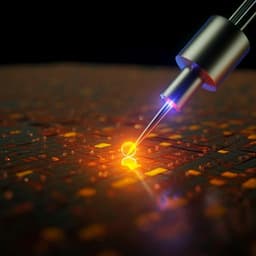
Physics
Hopping frustration-induced flat band and strange metallicity in a kagome metal
L. Ye, S. Fang, et al.
Discover how localized electronic states in the kagome metal Ni3In can drive remarkable changes in its physical properties, showcasing heavy fermion and strange metal behaviors. This groundbreaking research, conducted by authors including Linda Ye and Shiang Fang, delves into the interplay of magnetic fields, pressure, and quantum criticality, offering fresh perspectives on correlated metals with intriguing band topology.
~3 min • Beginner • English
Introduction
Landau Fermi liquid theory successfully describes interacting fermions in many metals via quasiparticles adiabatically connected to weakly interacting electrons. A canonical case involves conduction electrons interacting with localized magnetic moments (Kondo lattice), which can yield a renormalized heavy Fermi liquid or a metallic antiferromagnet, with the two connected by a quantum critical point where strange metal behavior emerges. Strange metal phenomenology also appears in cuprate superconductors and moiré heterostructures, motivating a broader search for its material origins. Kagome intermetallics offer a platform for correlated and topological phases associated with the trihexagonal lattice, including Dirac, van Hove, and flat-band states. Realizing ideal flat bands at the Fermi level is challenging due to longer-range hopping, orbital effects, and energetic placement. Nevertheless, correlated metallic phases can arise when narrow or partially flat bands approach the Fermi level. The intermetallic kagome metal Ni3In (space group P63/mmc) features a breathing Ni kagome network encircling In and, according to DFT, hosts a partially flat band at the Fermi level in the kz=0 plane with bandwidth W0 ~ 60 meV. With an expected Coulomb repulsion U ~ 1 eV (as in elemental Ni), U > W0 suggests incipient localization for a significant density of states. This work explores how destructive-interference-induced flatness in Ni 3d states in Ni3In produces localized-moment-like behavior interacting with itinerant carriers, leading to heavy fermion and strange metal signatures and proximity to quantum criticality.
Literature Review
The study builds on Kondo physics in f-electron systems where localized 4f/5f moments couple to conduction electrons, yielding heavy Fermi liquids, magnetic order, and quantum critical strange metal phases. Kondo-like behavior has also been observed in d-electron oxides and in 4d/5d-based van der Waals heterostructures, broadening the scope of correlated metals. Kagome intermetallics (e.g., Mn3Ge, FeSn, CoSn, CsV3Sb5) host Dirac fermions, van Hove singularities, flat bands, superconductivity, and large anomalous Hall effects linked to Berry curvature. Theoretical work emphasizes destructive quantum interference on frustrated lattices as a route to flat bands and correlated phases, including fractional topology. Prior challenges include deviations from ideal kagome models due to beyond-nearest-neighbor hopping and orbital complexity, and difficulty placing flat bands at EF. Comparisons are drawn to heavy-fermion quantum critical systems (e.g., CeCu5.9Au0.1) and iron pnictides (BaFe2(As1−xPx)2), which exhibit T-linear resistivity over broad temperature ranges. The work also relates to proposals of flat-band-driven Kondo phenomena with elevated energy scales and to heavy-fermion-like behavior in frustrated d-electron systems (e.g., LiV2O4) and moiré materials.
Methodology
Materials synthesis: Single crystals of Ni3In were grown via an I2-catalyzed reaction from Ni and In powders (3:1 molar ratio) sealed in evacuated quartz, heated to 800 °C for >2 weeks, yielding stable hexagonal prisms (300–500 μm). Ni3Sn crystals were grown by chemical vapor transport using I2 (5 mg/cm3) with a gradient 850→700 °C for 2 weeks, yielding needle-like crystals. Phases were confirmed by X-ray diffraction. Polycrystals of Ni3In1−xSnx were synthesized by solid-state reaction at 800 °C with repeated grinding/annealing for homogeneity; pellets were sintered for heat capacity measurements. SEM imaging used a FEI Helios Nanolab 600.
Transport and thermodynamics: Electrical transport was measured on single crystals and polycrystals using a standard five-probe method in a commercial cryostat and at the NHMFL DC field facility. Focused ion beam (FEI Helios Nanolab 600, Ga beam 21 nA) prepared ~5 μm-thick samples. Hydrostatic pressure resistivity used an HPC-33 piston cell with Daphne 7373 medium. Heat capacity on sintered polycrystals used the two-relaxation-time method. Magnetic susceptibility was measured by VSM in a Quantum Design MPMS3; magnetization up to 60 T was measured at the NHMFL Pulsed Field facility (LANL).
Scanning transmission electron microscopy: STEM on a JEOL ARM 200CFG (probe corrected) at 200 kV. Samples prepared by FIB (30 kV) followed by 1 keV Ar polish (Fischione Nanomill) for 15 minutes.
Angle-resolved photoemission spectroscopy: ARPES at ALS Beamline 7.0.2 (MAESTRO), micro-ARPES endstation with a Scienta Omicron R4000 analyzer. Ni3In surfaces were prepared by ex situ fine polishing followed by in situ Ar+ sputtering and 700 °C annealing; surface recovery verified by LEED. Ni3Sn was cleaved in situ at low temperature. Measurements were at ~80 K under UHV <4×10−11 torr, with p-polarized photons, photon energy 70–230 eV to map kx and kz via a nearly-free-electron final-state model with inner potential 10 eV. Energy/momentum resolutions were <20 meV and 0.01 Å−1.
First-principles calculations and modeling: DFT used VASP with PAW and PBE-GGA, plane-wave cutoff 360 eV and a 13×13×11 k-point grid. Wannier90 constructed tight-binding Hamiltonians from Ni 3d, 4s and In 5s states; an effective 6-band model projected from locally rotated dxz orbitals was derived. Additional DFT used FPLO (v18) to construct molecular-orbital-based Wannier projections combining Ni dxy and dxz orbitals on kagome triangles, yielding a model with two sites and two orbitals per site (four bands). Automatic wannierization also produced a full valence model for cross-checking susceptibilities. Local magnetic susceptibility χloc(ω=0) was evaluated from Matsubara Green’s functions on 24×24×24 k-grids; temperature dependence was contrasted with a simple 3D cubic single-band metal of 2 eV bandwidth and chemical potential at 0.5 eV. Momentum-resolved susceptibility χ(q) was computed in the qz=0 plane.
Key Findings
- DFT identifies a partially flat band at EF in Ni3In within the kz=0 plane with bandwidth W0 ~ 60 meV; with U ~ 1 eV (as in Ni), U > W0 implies strong correlation tendencies and incipient localization for these Ni 3d-derived states.
- In-plane resistivity ρab(T) shows broad shoulder upon cooling and becomes approximately linear in T below ~100 K down to ~1.5 K, indicating non-Fermi-liquid behavior. A Fermi-liquid T2 dependence ρ = ρ0 + AT2 appears only below TFL ≈ 1.5 K with A = 0.25 μΩ·cm·K−2 (much larger than in isostructural Ni3Sn, ~1×10−4 μΩ·cm·K−2 upper bound).
- Heat capacity Cp/T vs T2 exhibits a low-T upturn deviating from Cp/T = γ + βT2. Using the phonon slope from Ni3Sn, the Sommerfeld coefficient for Ni3In is γ = 51.6 mJ·K−2·mol−1 (about 5× Ni3Sn’s ~9 mJ·K−2·mol−1), indicating strong mass renormalization. The inferred D(EF) ≈ 44 eV−1 per unit cell (vs DFT ~14 eV−1), while for Ni3Sn the inferred D(EF) ≈ 7.6 eV−1 (50% larger than DFT 4.9 eV−1).
- The Kadowaki–Woods ratio is exceptionally large: Aab/γ2 = 91 μΩ·cm·mol2·K2·J−2, three orders of magnitude above elemental transition metals and comparable to heavy fermion and correlated oxide systems, indicating strong electron–electron scattering within the kagome plane.
- Magnetic field tuning: Increasing H suppresses the sublinear/linear T dependence, increases TFL, and reduces A, driving crossover from non-Fermi liquid (NFL) to Fermi liquid (FL); Cp/T is also suppressed by field.
- Pressure tuning: Hydrostatic pressure similarly suppresses NFL behavior and promotes FL character, mirroring field effects. Doping (Sn) also tunes behavior (Supplementary data).
- The temperature–field/pressure maps of the resistivity exponent α(T,H/P) reveal NFL regions near zero field/ambient pressure and FL recovery at higher fields/pressures and low T, consistent with proximity to a quantum critical point.
- Susceptibility calculations on the effective flat-band model show Curie–Weiss-like χloc(T) even without explicit correlations, indicating preformation of local moments. Momentum-resolved χ(q) is nearly q-independent in-plane, forming an extended hot region, consistent with localized magnetic fluctuations rather than itinerant hot spots.
- Magnetization and susceptibility data (including Curie–Weiss trends and field-suppressed fluctuations in magnetoresistance) support emergent local moments from flat-band states that strongly scatter conduction electrons, producing strange metallic T-linear resistivity above ~80 K and a heavy, renormalized FL below ~1 K.
- Ni3In also hosts a mirror-protected nodal ring near EF, suggesting possible interplay between topology and non-Fermi liquid transport.
Discussion
The work demonstrates that localized-moment-like behavior and strong correlations can emerge in a d-electron kagome metal from destructive-interference-induced flatness of Ni 3d bands rather than from intrinsically localized f orbitals. The partially flat band at EF enhances the density of states and promotes local-moment formation via U > W0. These moments interact with itinerant carriers, giving rise to heavy-fermion-like signatures (enhanced γ, large A and Kadowaki–Woods ratio) and strange metal transport (T-linear resistivity). Magnetic field and hydrostatic pressure tune the system from an NFL regime toward a low-temperature FL, consistent with a quantum critical phase diagram analogous to f-electron Kondo lattices (Doniach-type scenario), where field suppresses magnetic fluctuations and pressure enhances Kondo screening. The nearly momentum-independent χ(q) points to localized magnetic fluctuations associated with the flat band, supporting a band-origin Kondo lattice analogue. The similarity of the transport phenomenology to classic heavy fermions and correlated superconductors over widely different temperature scales underscores a potential unifying role of flat-band metallic states in generating strange metallicity and heavy quasiparticles. The presence of a nodal ring near EF opens opportunities to study the interplay between topology and non-Fermi-liquid behavior.
Conclusion
Ni3In realizes a d-electron route to heavy-fermion-like and strange metallic behavior via hopping-frustration-induced partial flat bands at the Fermi level. Transport and thermodynamic measurements reveal an NFL regime with T-linear resistivity, a low-T FL with a large A coefficient, a strongly enhanced Sommerfeld coefficient, and an exceptionally large Kadowaki–Woods ratio. Field and pressure tuning suppress the NFL behavior and enhance Fermi-liquid character, indicating proximity to quantum criticality akin to Kondo lattice systems. Theory and modeling support the formation of local moments from the flat band and localized magnetic fluctuations across the Brillouin zone. This establishes a lattice- and orbital-design paradigm, leveraging destructive interference in kagome networks to produce strong correlations and potentially entangle them with nontrivial band topology (e.g., nodal rings). Future work should seek to drive Ni3In across a quantum phase transition into an ordered state using additional tuning knobs (uniaxial stress, negative chemical pressure, carrier doping), investigate associated Fermi surface reconstructions, explore geometric frustration effects of the breathing kagome lattice, and compare with related kagome materials (e.g., CoSn) to dissect the roles of orbital character and dimensionality in flat-band-driven correlations.
Limitations
- Despite extensive tuning by magnetic field and hydrostatic pressure, no ordered phase was induced, limiting direct mapping of a full quantum critical phase diagram and identification of the ordered ground state beyond the NFL regime.
- The multiband electronic structure complicates quantitative extraction of scattering rates and the separation of contributions from different bands to transport and thermodynamics.
- ARPES on Ni3In required ex situ polishing and sputter/anneal cycles due to non-cleavable surfaces, which may introduce surface-related uncertainties despite LEED confirmation of recovery.
- Susceptibility and modeling indicate preformation of moments without explicit correlations, but a full many-body treatment (e.g., beyond DFT/Wannier models) is needed to capture Kondo screening scales and dynamical critical behavior quantitatively.
Related Publications
Explore these studies to deepen your understanding of the subject.







